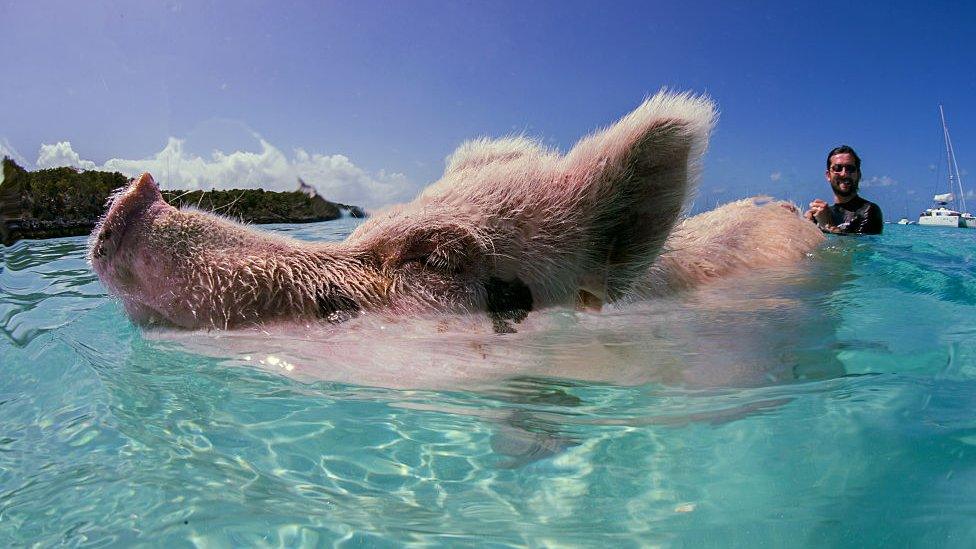Fyre Festival: My front-row seat for the chaos in the Exumas
- Published

It all looked so promising
Fyre Festival. If you think it sounds like the name of a new sort of natural disaster, you might not be wrong.
It started with an eye-catching video offering a luxury Bahamas festival weekend with models and celebrities galore. It ended with thousands of people stuck on a small island in tents meant for refugees, eating limp sandwiches from trays, and with the organiser, Billy McFarland, jailed for fraud.
As two new documentaries highlight the chaos of the Fyre Festival weekend in April 2017, writer T.R. Todd explains what he and others witnessed.

The party of the decade.
That's how the video promoted it. And it wasn't just any video: Bella Hadid and other supermodels, promoting an upcoming festival in the Exumas, an island chain in the Bahamas.
It promised luxury villas on the beach, gourmet chefs and a musical line-up topped by Blink 182 and provided by Kanye West's label.
There was a buried treasure hunt worth more than a million dollars. Oh, and they would fly you in on a private jet, touching down on an island once owned by former Colombian drug lord Pablo Escobar.
Allow YouTube content?
This article contains content provided by Google YouTube. We ask for your permission before anything is loaded, as they may be using cookies and other technologies. You may want to read Google’s cookie policy, external and privacy policy, external before accepting. To view this content choose ‘accept and continue’.
The backdrop was perfect: glamorous yachts, secluded beaches and the bluest, clearest water you had ever seen.
But for us, back then in February 2017, that video was just Exuma - our stomping ground. We had been up and down the archipelago a million times. If anything was happening in Exuma, we knew about it.
Yes, the water and beaches are that beautiful. And granted, there is indeed an island once owned by Escobar, otherwise known as Norman's Cay. That's where the truth ended.
The Fyre Festival, like it or not, was very definitely happening.
The man behind it was Billy McFarland, and the festival truly began when I heard the words: "Billy McFarland is at the gates."
I'll never forget those words.

I was sitting down to breakfast at the Grand Isle Resort, an upscale community in Great Exuma. After a few years at The Nassau Guardian, the country's largest newspaper, I was hired by Peter Nicholson, the largest owner at Grand Isle, to run his marketing and communications. He was beside me at the moment we got the call.
Billy McFarland is at the gates.
We stared at each other in disbelief. Just 48 hours earlier, I had made a call of my own. Like everyone else, I had seen that mind-blowing video, but I was worried.

Before Fyre Festival, Exuma was best known for its happy swimming pigs
Years before, we had launched a marketing campaign for the famous swimming pigs of the Exumas that spread around the world. For decades, these pigs had lived on a secluded island, all by themselves.
As tourists passed through, the pigs grew accustomed to swimming out to the boats for food. So in 2014, we released a documentary that received millions of hits, setting off a chain reaction of publicity that gave Exuma its first true taste of fame. I would later write a book about it.
We had also organised a small music concert for only a few hundred people, twice, and it almost killed me. I understood how hard it was to pull off an event on the islands.
But Fyre Festival? How was this even possible?
So I called them.

Exuma is made up of 365 islands and cays, small sandy spits of land. Most of these islands, the ones not owned by celebrities and business moguls, are incredibly isolated. They lack basic infrastructure.
You want to have a major, upscale festival in the Exuma Cays? It wasn't just "on the boundaries of the impossible", as they advertised. It's impossible, I told them.
I asked: have you ever heard of Great Exuma? (They hadn't).
It was clear they had no clue what they were doing. Worse: they had no idea where they were.
Then they showed up, marching through the gates of Grand Isle. There was a gaggle of models brandishing smartphones, beautiful people flanked by fancy marketing executives and event planners from New York.

"For locals, the Fyre Festival was a loss of livelihood, and some cases, the loss of their life savings"
Caught in the middle of it all were the locals, about 20 them, wearing black T-shirts and hats, all branded with the Fyre logo. It felt like they were transformed by Fyre, or indoctrinated into some cult. The brand's orange zigzag with the flame on top would soon spread all over the island.
It was such a departure from the Exuma we all knew and loved.
There isn't a single traffic light on the island. There is one main road. And if you don't pick up a hitchhiker, that's rude. Millionaires and billionaires mill around locals with a few dollars in their pockets.
People come here to disappear, to melt into the landscape, to just be themselves. Exuma is arguably the most beautiful place in the world, but it is unpretentious.
Fyre felt like the opposite. It was flashy. It was shallow.
The entourage made for the bar, ordering whatever they wanted. It was clear that money was not a concern.
And then there was Billy: the ultimate millennial villain.

Organiser Billy McFarland on a jet ski. He was later jailed for six years after pleading guilty to fraud.
When I'd see him in the following weeks, it was always the same: a big smile, a handshake, a pleasant word, but then he'd dash behind a phone or computer. To me, he was never at ease with himself or those around him. And he never listened.
I was by Nicholson's side when he told Billy: "Don't do this."
With the right expectations, Fyre Festival could have been successful. But they needed at least six or eight months, maybe even a year, to prepare. At this point, they had three months.
Despite all the warnings, McFarland couldn't be stopped. If it was going to happen anywhere, it was on Great Exuma, right across the street from Grand Isle.
So much of those three months were a blur. McFarland and his team never allowed anyone on site. There was a sense that they weren't ready, but nobody knew just how bad it was.

Guests were promised luxury accommodation - they got this. And then the rain started.
On 27 April, the day before the festival was due to start, I walked down in the rain to the restaurant where three months earlier I had first laid eyes on Billy McFarland. The place was jammed with partying millennials. Many of them were influencers with hundreds of thousands, if not millions, of followers.
It wasn't long before the hysteria set in, when people saw the tents they would actually be staying in.
By now, we all know what happened next. Because so many of them were influencers, the Fyre Festival is engrained in us through images on social media: the disaster relief tents, that infamous cheese sandwich in Styrofoam.
Allow X content?
This article contains content provided by X. We ask for your permission before anything is loaded, as they may be using cookies and other technologies. You may want to read X’s cookie policy, external and privacy policy, external before accepting. To view this content choose ‘accept and continue’.

I mostly saw it play out from Grand Isle, with people begging me for a bed, a couch or a pillow on the floor. Some of them frantically called home and stomped around in anger. Others were in a state of shock, weeping silently to themselves in frustration. Well-to-do millennials were now affectionately known as "refugees". We took in as many of them as we could, as did others at Grand Isle. It could have been a lot worse. In the end, they all went back to their normal lives.
What was lost in it all, however, were the locals. They didn't have millions of followers. This was their home.
For them, the Fyre Festival was more than a rip-off, a disappointment or an inconvenience. It was a loss of livelihood, and in some cases, the loss of their life savings. It shattered a dream and the promise of something better. Fyre consumed everyone in its path, especially the less fortunate that needed it most.
Everyone wanted the fantasy to be real.

That night, I went over to the festival site to see it with my own eyes.
There were hundreds of Bahamians that had worked day and night to try and make the impossible possible.
Defeated, with tears in his eyes, one of the festival's organisers had one request: can you help get these workers home?
So in the middle of the night, I jammed our car full of workers, people that would never get paid. It was pitch black because the roads don't have street lights. The houses don't have addresses.
I would later find out these people were from the capital Nassau, not Exuma, because the festival couldn't find enough labour on the island. An hour or two later, we eventually found a nondescript, darkened house, and I began my long drive back to Grand Isle.
Fortunately for the locals, there may yet be a happy ending.

Earlier this month, two documentaries on the festival were released. The Netflix documentary, Fyre: The Greatest Party That Never Happened, tells the story of Maryann Rolle, who owns the restaurant Exuma Point with her husband, Elvis.
She bore the brunt of the chaos, feeding up to a thousand people a day without ever getting paid. In the documentary, she says she lost $50,000 (£38,000) of her savings.
Since the documentary aired, a GoFundMe page has raised more than $190,000 for her family. And now, together with the filmmakers and the Exuma Foundation, we have set up another GoFundMe page to help the hundreds of other workers impacted by Fyre.
The same social media monster that helped create Fyre may also provide salvation for the people of Exuma.
T.R. Todd is a journalist, biographer and novelist now based in Ottawa, Canada.
- Published22 January 2019

- Published18 January 2019

- Published21 January 2019

- Published11 October 2018
